publications
2024
-
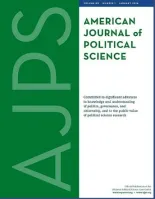 Causal Inference with Latent OutcomesLukas F Stoetzer, Xiang Zhou, and Marco SteenbergenAmerican Journal of Political Science 2024
Causal Inference with Latent OutcomesLukas F Stoetzer, Xiang Zhou, and Marco SteenbergenAmerican Journal of Political Science 2024While causal inference has become front and center in empirical political science, we know little about how to analyze causality with latent outcomes, such as political values, beliefs, and attitudes. In this article, we develop a framework for defining, identifying, and estimating the causal effect of an observed treatment on a latent outcome, which we call the latent treatment effect (LTE). We describe a set of assumptions that allow us to identify the LTE and propose a hierarchical item response model to estimate it. We highlight an often overlooked exclusion restriction assumption, which states that treatment status should not affect the observed indicators other than through the latent outcome. A simulation study shows that the hierarchical approach offers unbiased estimates of the LTE under the identification and modeling assumptions, whereas conventional two-step approaches are biased. We illustrate our proposed methodology using data from two published experimental studies
-
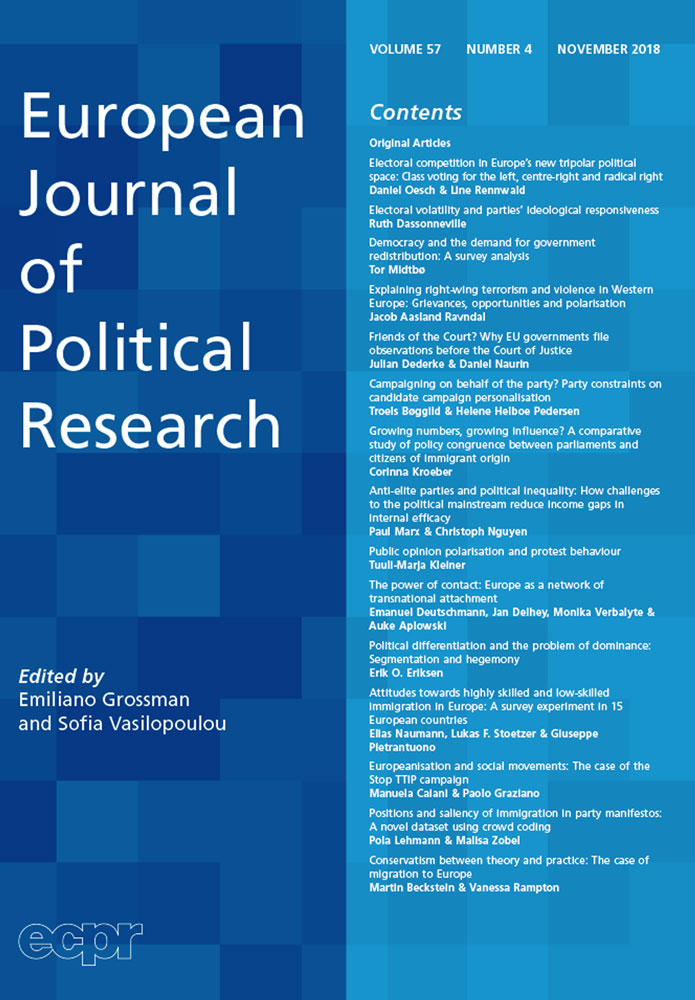 The backlash against free movement: Does EU-internal migration fuel public concerns about immigration?Lukas F Stoetzer, Martin Kroh, and Leonard DaseyEuropean Journal of Political Research 2024
The backlash against free movement: Does EU-internal migration fuel public concerns about immigration?Lukas F Stoetzer, Martin Kroh, and Leonard DaseyEuropean Journal of Political Research 2024The free movement of people is a fundamental principle of the European Union (EU) that has led to an increase in EU-internal migration. This study investigates the impact of increased immigration to Germany resulting from the 2004 and 2007 eastern enlargement of the EU on concerns about immigration within the German population. By merging 20 years of annual migration statistics with panel data on individual attitudes and exploiting exogenous variation in the gradual enlargement of the free movement policy, we examine the causal effects of EU-internal migration on immigration concerns. Our findings suggest that the influx of immigrants from new member states did not have a clear average effect on concerns about immigration, but increased concerns among German natives with materialist-survival values. The study provides insights into the societal division caused by opposition to immigration as part of the European integration process.
-
 Extreme weather events do not increase political parties’ environmental attentionNature Climate Change 2024
Extreme weather events do not increase political parties’ environmental attentionNature Climate Change 2024Exposure to extreme weather events can make people more aware of environmental changes; however, it remains unclear how such events influence politicians’ behaviour. Combining supervised learning algorithms on over 260,000 press releases by European parties with a difference-in-differences design, we find that apart from Green parties, extreme weather events do not increase attention towards environmental issues. This suggests the consequences of climate change might not directly increase political attention.
@article{wappenhans2022, bibtex_show = {true}, status = {published}, year = {2024}, title = {Extreme weather events do not increase political parties' environmental attention}, author = {Wappenhans, Tim and Valentim, Antonio and Klüver, Heike and Stoetzer, Lukas F}, impact = {2}, journal = {Nature Climate Change}, website = {https://doi.org/10.1038/s41558-024-02024-z}, published = {European Political Science Association Conference 2022}, preview = {ncc.png} } -
 Learning from Polls During Electoral CampaignsLukas F Stoetzer, Lucas Leemann, and Richard TraunmuellerPolitical Behavior 2024
Learning from Polls During Electoral CampaignsLukas F Stoetzer, Lucas Leemann, and Richard TraunmuellerPolitical Behavior 2024Voters’ beliefs about the strength of political parties are a central part of many foundational political science theories. In this article, we present a dynamic Bayesian learning model that allows us to study how voters form these beliefs by learning from pre-election polls over the course of an election campaign. In the model, belief adaptation to new polls can vary due to the perceived precision of the poll or the reliance on prior beliefs. We evaluate the implications of our model using two experiments. We find that respondents update their beliefs assuming that the polls are relatively imprecise but still weigh them more strongly than their priors. Studying implications for motivational learning by partisans, we find that varying adaptation works through varying reliance on priors and not necessarily by discrediting a poll’s precision. The findings inform our understanding of the consequences of learning from polls during political campaigns and motivational learning in general.
@article{stoetzer2022learning, status = {published}, bibtex_show = {true}, title = {Learning from Polls During Electoral Campaigns}, website = {https://doi.org/10.1007/s11109-022-09837-8}, author = {Stoetzer, Lukas F and Leemann, Lucas and Traunmueller, Richard}, journal = {Political Behavior}, preview = {pb.jpg}, impact = {2}, code = {https://doi.org/10.7910/DVN/IW4FP8}, pages = {543-564}, year = {2024}, volume = {4}, issue = {1}, publisher = {Springer US} } -
 Voter expectations in district elections without local pollsPublic Opinion Quarterly 2024
Voter expectations in district elections without local pollsPublic Opinion Quarterly 2024How do voters form accurate expectations about the strength of political candidates in constituency elections if there are no reliable constituency polls available? We argue that voters can use national election polls and past election results to increase the accuracy of their expectations. A survey experiment during the German federal election of 2021 confirms that the provision of national election polls and past results increases the accuracy of voters’ expectations. The analysis further shows that voters leverage the information to update their beliefs. The results have relevant implications for debates about belief formation in low-information environments.
@article{stoetzer2023, bibtex_show = {true}, status = {published}, year = {2024}, title = {Voter expectations in district elections without local polls}, author = {Stoetzer, Lukas F and Kayser, Mark and Leininger, Arndt and Murr, Andreas}, impact = {3}, volume = {88}, issue = {2}, pages = {408–418}, journal = {Public Opinion Quarterly}, preview = {poq2.jpeg} }
2023
-
 Affective partisan polarization and moral dilemmas during the COVID-19 pandemicLukas F Stoetzer, Simon Munzert, Will Lowe, Başak Çalı, Anita R Gohdes, Marc Helbling, Rahsaan Maxwell, and Richard TraunmüllerPolitical Science Research and Methods 2023
Affective partisan polarization and moral dilemmas during the COVID-19 pandemicLukas F Stoetzer, Simon Munzert, Will Lowe, Başak Çalı, Anita R Gohdes, Marc Helbling, Rahsaan Maxwell, and Richard TraunmüllerPolitical Science Research and Methods 2023Recent scholarship on affective polarization documents partisan animosity in people’s everyday lives. But does partisan dislike go so far as to deny fundamental rights? We study this question through a moral dilemma that gained notoriety during the COVID-19 pandemic: triage decisions on the allocation of intensive medical care. Using a conjoint experiment in five countries we analyze the influence of patients’ partisanship next to commonly discussed factors determining access to intensive medical care. We find that while participants’ choices are consistent with a utilitarian heuristic, revealed partisanship influences decisions across most countries. Supporters of left or right political camps are more likely to withhold support from partisan opponents. Our findings offer comparative evidence on affective polarization in non-political contexts.
@article{stoetzer2021affective, status = {published}, bibtex_show = {true}, title = {Affective partisan polarization and moral dilemmas during the COVID-19 pandemic}, project = {ineq}, impact = {1}, website = {https://doi.org/10.1017/psrm.2022.13}, preview = {psrm.jpg}, code = {https://doi.org/10.7910/DVN/SURAOE}, author = {Stoetzer, Lukas F and Munzert, Simon and Lowe, Will and {\c{C}}al{\i}, Ba{\c{s}}ak and Gohdes, Anita R and Helbling, Marc and Maxwell, Rahsaan and Traunm{\"u}ller, Richard}, journal = {Political Science Research and Methods}, pages = {429 - 436}, year = {2023}, volume = {11}, number = {2}, publisher = {Cambridge University Press} } -
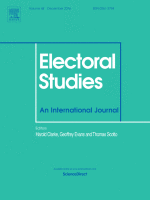 Can wedge strategies by mainstream parties cross-cut the far right vote?Electoral Studies 2023
Can wedge strategies by mainstream parties cross-cut the far right vote?Electoral Studies 2023Anti-immigration campaigns have helped far right parties to establish themselves in party systems around the world. We examine whether mainstream parties can employ wedge issue campaigns that divide the far right anti-immigration vote to win back electoral support. Wedge issues that cross-cut the anti-immigration vote may enhance the electoral support of mainstream parties, as long as they do not simultaneously alienate pro-immigration voters. We evaluate this expectation using a panel survey experiment conducted during the 2021 German federal election. The first wave allows us to identify wedge issues that the mainstream CDU/CSU can stress to cross-cut the anti-immigration vote. The second wave raises the salience of these issues by manipulating the perceived issue agenda of the CDU/CSU using hypothetical campaign posters. While our results show that wedge issue strategies are not effective on average, exploratory analyses reveal the potential of strategically targeted messaging in winning back support of some anti-immigration voters.
@article{haas2022, bibtex_show = {true}, title = {Can wedge strategies by mainstream parties cross-cut the far right vote?}, author = {Haas, Violeta and Stoetzer, Lukas F and Klüver, Heike and Schleiter, Petra}, impact = {2}, preview = {es.gif}, year = {2023}, status = {published}, journal = {Electoral Studies}, page = {102617}, volume = {83}, website = {https://doi.org/10.1016/j.electstud.2023.102617} } -
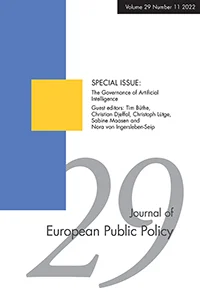 How does income inequality affect the support for populist parties?Lukas F Stoetzer, Johannes Giesecke, and Heike KlüverJournal of European Public Policy 2023
How does income inequality affect the support for populist parties?Lukas F Stoetzer, Johannes Giesecke, and Heike KlüverJournal of European Public Policy 2023Recent studies provide evidence that income inequality is a relevant driver for the electoral success of populist parties all over Europe. In this article, we aim to understand how exactly increasing income inequality can lead to support for populist parties. More specifically, we discuss four different attitudinal mechanisms from previous research: economic insecurities, trust in political elites, social integration, and national identity. We rely on eight waves of the European Social Survey and find that economic insecurities, trust in political elites, and national identity are linked to rising income inequality and populist support as expected. However, a causal mediation analysis shows that these mechanisms are not sufficient to fully understand the impact of income inequality on support for populists. This finding raises questions regarding the empirical support of existing theories to explain how macroeconomic changes in inequality became a pre-condition for the rise of populist parties.
@article{stoetzer2023income, status = {published}, bibtex_show = {true}, preview = {jepp.png}, website = {https://doi.org/10.1080/13501763.2021.1981981}, project = {ineq}, title = {How does income inequality affect the support for populist parties?}, impact = {2}, volume = {23}, number = {1}, author = {Stoetzer, Lukas F and Giesecke, Johannes and Kl{\"u}ver, Heike}, journal = {Journal of European Public Policy}, pages = {1--20}, year = {2023}, blog = {https://blogs.lse.ac.uk/europpblog/2021/11/11/how-does-income-inequality-affect-support-for-populist-parties/}, publisher = {Routledge} } -
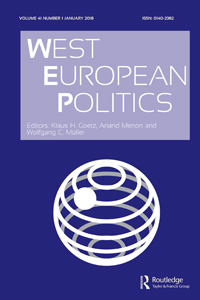 Group-based public opinion polarisation in multi-party systemsDenise Traber, Lukas F Stoetzer, and Tanja BurriWest European Politics 2023
Group-based public opinion polarisation in multi-party systemsDenise Traber, Lukas F Stoetzer, and Tanja BurriWest European Politics 2023Public opinion polarisation can impair society’s ability to reach a democratic consensus in different political issue areas. This appears particularly true when the polarisation of opinions coincides with clearly identifiable social groups. The literature on public opinion polarisation has mostly focussed on the US two-party context. We lack concepts and measures that can be adapted to European countries with multi-party systems and multi-layered group identities. This article proposes a conceptualisation of polarisation between groups in society. It presents a measure that captures the overlap of ideology distributions between groups. The two-step empirical framework includes hierarchical IRT models and a measure for dissimilarity of distributions. The second part presents an empirical application of the measure based on survey data from Switzerland (1994–2016), which reveals insightful dynamics of public opinion polarisation between party supporters and education groups.
@article{traber2023, status = {published}, bibtex_show = {true}, preview = {wep.jpeg}, project = {ineq}, impact = {2}, website = {https://doi.org/10.1080/01402382.2022.2110376}, title = {Group-based public opinion polarisation in multi-party systems}, author = {Traber, Denise and Stoetzer, Lukas F and Burri, Tanja}, journal = {West European Politics}, pages = {631--651}, year = {2023}, volume = {46}, number = {4}, publisher = {Routledge} } -
 When Knowledge Is Not Enough. Individual Preconditions for Strategic VotingBenjamin Schlegel, Patrick Kraft, and Lukas F StoetzerElectoral Studies 2023
When Knowledge Is Not Enough. Individual Preconditions for Strategic VotingBenjamin Schlegel, Patrick Kraft, and Lukas F StoetzerElectoral Studies 2023Voters often have to decide between supporting their preferred candidate or choosing a less appealing but more viable alternative. What are the underlying mechanisms that enable citizens to navigate these strategic trade-offs? Combining experimental and observational evidence from the UK, we differentiate three crucial preconditions for strategic voting—motivation, information, and capabilities—and provide converging evidence illuminating how these factors interact. Specifically, we find that high levels of motivation are a necessary condition for the beneficial effects of information and capabilities to manifest. Our findings suggest that a narrow focus on political knowledge to improve strategic voting and thereby democratic representation is short-sighted. Methodologically, we offer a novel experimental framework that enables researchers to independently manipulate different mechanisms underlying citizen competence.
-
 The PARTYPRESS Database: A New Comparative Database of Parties’ Press ReleasesCornelius Erfort, Lukas F Stoetzer, and Heike Klüver2023
The PARTYPRESS Database: A New Comparative Database of Parties’ Press ReleasesCornelius Erfort, Lukas F Stoetzer, and Heike Klüver2023We present the PARTYPRESS Database, which compiles more than 250,000 published press releases from 68 parties in nine European countries. The database covers the press releases of the most relevant political parties in these countries from 2010 onward. It provides a supervised machine learning classification of press releases into 21 unique issue categories according to a general codebook. The PARTYPRESS Database can be used to study parties’ issue agendas comparatively and over time. We extend a recent analysis in Gessler and Hunger (2022) to illustrate the usefulness of the database in studying dynamic party competition, communication, and behavior.
2022
-
 Non-Separable Preferences in the Statistical Analysis of Roll Call VotesGarret Binding, and Lukas F StoetzerPolitical Analysis 2022
Non-Separable Preferences in the Statistical Analysis of Roll Call VotesGarret Binding, and Lukas F StoetzerPolitical Analysis 2022Conventional multidimensional statistical models of roll call votes assume that legislators’ preferences are additively separable over dimensions. In this article, we introduce an item response model of roll call votes that allows for non-separability over latent dimensions. Conceptually, non-separability matters if outcomes over dimensions are related rather than independent in legislators’ decisions. Monte Carlo simulations highlight that separable item response models of roll call votes capture non-separability via correlated ideal points and higher salience of a primary dimension. We apply our model to the U.S. Senate and the European Parliament. In both settings, we find that legislators’ preferences over two basic dimensions are non-separable. These results have general implications for our understanding of legislative decision-making, as well as for empirical descriptions of preferences in legislatures.
@article{binding2022non, status = {published}, bibtex_show = {true}, title = {Non-Separable Preferences in the Statistical Analysis of Roll Call Votes}, preview = {pa.jpg}, impact = {1}, website = {https://doi.org/10.1017/pan.2022.11}, author = {Binding, Garret and Stoetzer, Lukas F}, code = {https://doi.org/10.7910/DVN/XLY5AJ}, journal = {Political Analysis}, pages = {1--14}, year = {2022}, publisher = {Cambridge University Press} } -
 Prioritization preferences for COVID-19 vaccination are consistent across five countriesHumanities and Social Sciences Communications 2022
Prioritization preferences for COVID-19 vaccination are consistent across five countriesHumanities and Social Sciences Communications 2022Vaccination against COVID-19 is making progress globally, but vaccine doses remain a rare commodity in many parts of the world. New virus variants require vaccines to be updated, hampering the availability of effective vaccines. Policymakers have defined criteria to regulate who gets priority access to the vaccination, such as age, health complications, or those who hold system-relevant jobs. But how does the public think about vaccine allocation? To explore those preferences, we surveyed respondents in Brazil, Germany, Italy, Poland, and the United States from September to December of 2020 using ranking and forced-choice tasks. We find that public preferences are consistent with expert guidelines prioritizing health-care workers and people with medical preconditions. However, the public also considers those signing up early for vaccination and citizens of the country to be more deserving than later-comers and non-citizens. These results hold across measures, countries, and socio-demographic subgroups.
@article{munzert2022prioritization, status = {published}, bibtex_show = {true}, website = {https://www.nature.com/articles/s41599-022-01392-1}, preview = {nat2.jpg}, title = {Prioritization preferences for COVID-19 vaccination are consistent across five countries}, author = {Munzert, Simon and Ramirez-Ruiz, Sebastian and {\c{C}}al{\i}, Ba{\c{s}}ak and Stoetzer, Lukas F and Gohdes, Anita and Lowe, Will}, journal = {Humanities and Social Sciences Communications}, volume = {9}, number = {1}, impact = {2}, pages = {1--10}, year = {2022}, publisher = {Palgrave} } -
 The Zweitstimme model: A dynamic forecast of the 2021 German federal electionPS: Political Science & Politics 2022
The Zweitstimme model: A dynamic forecast of the 2021 German federal electionPS: Political Science & Politics 2022@article{gschwend2022zweitstimme, status = {published}, bibtex_show = {true}, title = {The Zweitstimme model: A dynamic forecast of the 2021 German federal election}, impact = {3}, website = {https://doi.org/10.1017/S1049096521000913}, preview = {ps.jpg}, author = {Gschwend, Thomas and M{\"u}ller, Klara and Munzert, Simon and Neunhoeffer, Marcel and Stoetzer, Lukas F}, journal = {PS: Political Science \& Politics}, volume = {55}, number = {1}, pages = {85--90}, year = {2022}, publisher = {Cambridge University Press} }
2021
-
 Eliciting beliefs as distributions in online surveysLucas Leemann, Lukas F Stoetzer, and Richard TraunmüllerPolitical Analysis 2021
Eliciting beliefs as distributions in online surveysLucas Leemann, Lukas F Stoetzer, and Richard TraunmüllerPolitical Analysis 2021Citizens’ beliefs about uncertain events are fundamental variables in many areas of political science. While beliefs are often conceptualized in the form of distributions, obtaining reliable measures in terms of full probability densities is a difficult task. In this letter, we ask if there is an effective way of eliciting beliefs as distributions in the context of online surveys. Relying on experimental evidence, we evaluate the performance of five different elicitation methods designed to capture citizens’ uncertain expectations. Our results suggest that an elicitation method originally proposed by Manski (2009) performs well. It measures average citizens’ subjective belief distributions reliably and is easily implemented in the context of regular (online) surveys. We expect that a wider use of this method will lead to considerable improvements in the study of citizens’ expectations and beliefs.
@article{leemann2021eliciting, bibtex_show = {true}, status = {published}, preview = {pa.jpg}, website = {https://doi.org/10.1017/pan.2020.42}, title = {Eliciting beliefs as distributions in online surveys}, author = {Leemann, Lucas and Stoetzer, Lukas F and Traunm{\"u}ller, Richard}, impact = {1}, journal = {Political Analysis}, volume = {29}, number = {4}, pages = {541--553}, year = {2021}, publisher = {Cambridge University Press}, selected = {true}, code = {https://doi.org/10.7910/DVN/GEC2LS} } -
 Tracking and promoting the usage of a COVID-19 contact tracing appNature Human Behaviour 2021
Tracking and promoting the usage of a COVID-19 contact tracing appNature Human Behaviour 2021Digital contact tracing apps have been introduced globally as an instrument to contain the COVID-19 pandemic. Yet, privacy by design impedes both the evaluation of these tools and the deployment of evidence-based interventions to stimulate uptake. We combine an online panel survey with mobile tracking data to measure the actual usage of Germany’s official contact tracing app and reveal higher uptake rates among respondents with an increased risk of severe illness, but lower rates among those with a heightened risk of exposure to COVID-19. Using a randomized intervention, we show that informative and motivational video messages have very limited effect on uptake. However, findings from a second intervention suggest that even small monetary incentives can strongly increase uptake and help make digital contact tracing a more effective tool.
@article{munzert2021tracking, status = {published}, bibtex_show = {true}, preview = {nhb.png}, website = {https://www.nature.com/articles/s41562-020-01044-x}, title = {Tracking and promoting the usage of a COVID-19 contact tracing app}, impact = {1}, author = {Munzert, Simon and Selb, Peter and Gohdes, Anita and Stoetzer, Lukas F and Lowe, Will}, journal = {Nature Human Behaviour}, volume = {5}, number = {2}, pages = {247--255}, year = {2021}, publisher = {Nature Publishing Group}, selected = {true}, code = {https://github.com/simonmunzert/covid19-app-experiment} } -
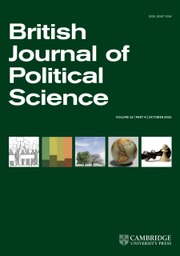 The Two Faces of Party Ambiguity: A Comprehensive Model of Ambiguous Party Position PerceptionsDominic Nyhuis, and Lukas F StoetzerBritish Journal of Political Science 2021
The Two Faces of Party Ambiguity: A Comprehensive Model of Ambiguous Party Position PerceptionsDominic Nyhuis, and Lukas F StoetzerBritish Journal of Political Science 2021Recent research on electoral behavior has suggested that policy-informed vote choices are frequently obstructed by uncertainty about party positions. Given the significance of clear and distinct party platforms for meaningful representation, several studies have investigated the conditions under which parties are perceived as ambiguous. Yet previous studies have often relied on measures of perceived positional ambiguity that are fairly remote from the concept, casting doubt on their substantive conclusions. This article introduces a statistical model to estimate a comprehensive measure of perceived ambiguity that incorporates the two principal factors: non-positions and positional inconsistency. The two-faces model employs issue perceptions in an item response framework to explicitly parametrize the perceived ambiguity of party positions. The model is applied to data from the Chapel Hill Expert Survey and subsequently associated with party characteristics that drive perceptions of party ambiguity. The results suggest that (a) there are notable differences between the proposed and competing measures, highlighting the need to be mindful of the intricacies of political information processing in research on perceptions of ambiguity and (b) involuntary ambiguity might be an underexplored explanation for unclear party perceptions.
@article{nyhuis2021two, bibtex_show = {true}, status = {published}, website = {https://doi.org/10.1017/S0007123419000759}, preview = {bjps.jpg}, title = {The Two Faces of Party Ambiguity: A Comprehensive Model of Ambiguous Party Position Perceptions}, impact = {2}, author = {Nyhuis, Dominic and Stoetzer, Lukas F}, code = {https://doi.org/10.7910/DVN/4SRS4X}, journal = {British Journal of Political Science}, volume = {51}, number = {4}, pages = {1421--1438}, year = {2021}, publisher = {Cambridge University Press} } -
 The effect of televised candidate debates on the support for political partiesKorinna Lindemann, and Lukas F StoetzerElectoral Studies 2021
The effect of televised candidate debates on the support for political partiesKorinna Lindemann, and Lukas F StoetzerElectoral Studies 2021During campaigns for legislative elections, a large portion of the general public follows televised debates between the front-running candidates. How can the candidates use the public interest in the debates to increase the support for their party? In this article, we argue that especially challenger candidates can improve the public perception of their valence qualities, such as personal integrity, leadership, and competence, and can - as a result - raise the support of their party. We expect that the perceived policy stances of the candidates matter less. Building on televised debate experiments during the German Federal Elections of 2009 and 2013, we analyse the effect of the debates on party vote and in how far this relationship is mediated by changes in valence and policy evaluations of the candidates. Results show that changes of candidate valence, but not changes in policy perceptions, of the social-democratic front-running candidates mediate the vote intention for the party. Respondents who perceived the candidates more competent, empathetic and have integrity as a result of the debate are more likely to vote for the candidate’s party. Our analysis further reveals, however, that this valence effect is not long-lasting and does not carry-over to vote intention briefly before the election.
@article{lindemann2021effect, status = {published}, bibtex_show = {true}, preview = {es.gif}, impact = {2}, website = {https://www.sciencedirect.com/science/article/abs/pii/S0261379420301220}, title = {The effect of televised candidate debates on the support for political parties}, author = {Lindemann, Korinna and Stoetzer, Lukas F}, journal = {Electoral Studies}, volume = {69}, pages = {102243}, year = {2021}, publisher = {Pergamon} } -
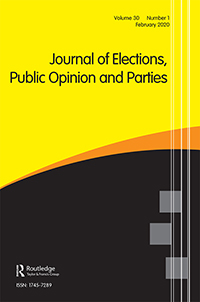 Whose dimension is it anyway? Elite ideology and the exposed partisan public in the USLukas F StoetzerJournal of Elections, Public Opinion and Parties 2021
Whose dimension is it anyway? Elite ideology and the exposed partisan public in the USLukas F StoetzerJournal of Elections, Public Opinion and Parties 2021A multitude of political science research assumes that the same ideological dimension guides the interaction between citizens and elites. Public opinion research has repeatedly underlined that this assumption is unlikely to apply to the entire public. In this article, I test the expectation that the interplay between exposure to public debate information and partisan identities makes citizens align their preferences with the elite ideological dimension. I develop a joint scaling model for citizens’ and legislators’ preferences that allows for heteroscedastic deviations of citizens’ policy preferences from the elite model. Applications to the Cooperative Congressional Election Study of 2008–2012 and the Senator Representation Study show that elite ideology can be a more reliable constraint on political preferences for exposed partisans, compared to unexposed non-partisans. The findings have implications for studies of party strategies, representation and political behavior that build on the assumption of shared ideological dimensions.
@article{stoetzer2021whose, status = {published}, bibtex_show = {true}, preview = {jeps.jpeg}, impact = {2}, website = {https://doi.org/10.1080/17457289.2021.1917583}, title = {Whose dimension is it anyway? Elite ideology and the exposed partisan public in the US}, author = {Stoetzer, Lukas F}, code = {https://github.com/lstoetze/girt-rpackage}, journal = {Journal of Elections, Public Opinion and Parties}, pages = {1--22}, year = {2021}, publisher = {Routledge} } -
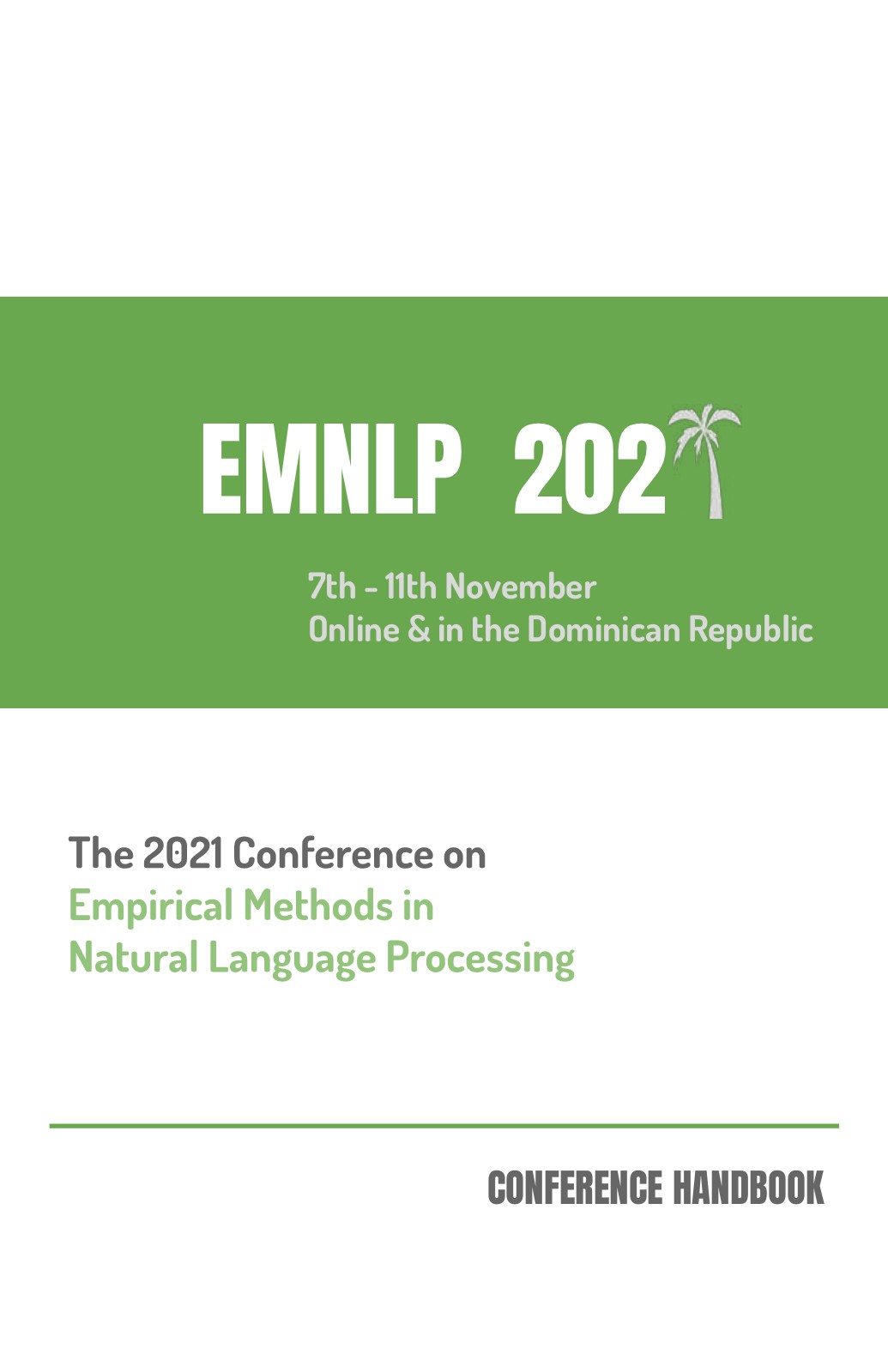 Come hither or go away? Recognising pre-electoral coalition signals in the newsInes Rehbein, Simone Paolo Ponzetto, Anna Adendorf, Oke Bahnsen, Lukas Stoetzer, and Heiner StuckenschmidtIn Proceedings of the 2021 Conference on Empirical Methods in Natural Language Processing 2021
Come hither or go away? Recognising pre-electoral coalition signals in the newsInes Rehbein, Simone Paolo Ponzetto, Anna Adendorf, Oke Bahnsen, Lukas Stoetzer, and Heiner StuckenschmidtIn Proceedings of the 2021 Conference on Empirical Methods in Natural Language Processing 2021In this paper, we introduce the task of political coalition signal prediction from text, that is, the task of recognizing from the news coverage leading up to an election the (un)willingness of political parties to form a government coalition. We decompose our problem into two related, but distinct tasks: (i) predicting whether a reported statement from a politician or a journalist refers to a potential coalition and (ii) predicting the polarity of the signal – namely, whether the speaker is in favour of or against the coalition. For this, we explore the benefits of multi-task learning and investigate which setup and task formulation is best suited for each sub-task. We evaluate our approach, based on hand-coded newspaper articles, covering elections in three countries (Ireland, Germany, Austria) and two languages (English, German). Our results show that the multi-task learning approach can further improve results over a strong monolingual transfer learning baseline.
@inproceedings{rehbein2021come, status = {published}, bibtex_show = {true}, title = {Come hither or go away? Recognising pre-electoral coalition signals in the news}, preview = {emnlp.jpg}, project = {pec}, impact = {3}, website = {https://aclanthology.org/2021.emnlp-main.615}, author = {Rehbein, Ines and Ponzetto, Simone Paolo and Adendorf, Anna and Bahnsen, Oke and Stoetzer, Lukas and Stuckenschmidt, Heiner}, booktitle = {Proceedings of the 2021 Conference on Empirical Methods in Natural Language Processing}, pages = {7798--7810}, year = {2021}, pdf = {2021.emnlp-main.615} }
2020
-
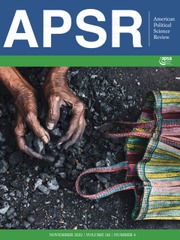 How parties react to voter transitionsTarik Abou-Chadi, and Lukas F StoetzerAmerican Political Science Review 2020
How parties react to voter transitionsTarik Abou-Chadi, and Lukas F StoetzerAmerican Political Science Review 2020This letter investigates how voter transitions between parties affect parties’ policy positioning. While a growing literature investigates the role of election results as signals for parties’ policy adaption, it has mostly focused on vote changes of individual parties. However, parties do not know only whether they have won or lost in an election; they also have detailed information on which parties they won votes from and which parties they lost votes to. We make two arguments about how voter transitions should affect the strategic policy choices of political parties. First, when a party has lost votes to another party it will adapt its policy positions toward that party. Second, parties that have overall lost more votes become more likely to adapt their positions. Making use of a data set on individual voter transitions and party positions we can demonstrate that voter transitions indeed affect parties’ competitive behavior.
@article{abou2020parties, bibtex_show = {true}, status = {published}, preview = {apsr.jpg}, impact = {1}, website = {https://doi.org/10.1017/S0003055420000155}, title = {How parties react to voter transitions}, author = {Abou-Chadi, Tarik and Stoetzer, Lukas F}, journal = {American Political Science Review}, volume = {114}, number = {3}, pages = {940--945}, year = {2020}, publisher = {Cambridge University Press}, selected = {true}, code = {https://doi.org/10.7910/DVN/HULLNG} } -
 Vote choice and the nonseparability of economic and social issuesLukas F Stoetzer, and Steffen ZittlauPublic Opinion Quarterly 2020
Vote choice and the nonseparability of economic and social issuesLukas F Stoetzer, and Steffen ZittlauPublic Opinion Quarterly 2020How voters use political issues to elect political candidates is of central importance to our understanding of democratic representation. Research on voting behavior often assumes that American voters hold distinct economic and cultural issue preferences. In this research note, we point out that this does not necessarily imply that preferences for candidates’ positions on the two issue dimensions are also additively separable in voters’ decisions. Analyzing survey data on US presidential elections from 1996 to 2016, we estimate to what extent voters’ economic and socio-cultural preferences are nonseparable and find that the two general dimensions act as substitutes in their decisions. Our finding implies that voting decisions are partially structured by an underlying single dimension, as liberal deviations from a voter’s ideal point on social issues can be compensated by conservative deviations on economic issues.
@article{stoetzer2020vote, bibtex_show = {true}, status = {published}, title = {Vote choice and the nonseparability of economic and social issues}, impact = {2}, author = {Stoetzer, Lukas F and Zittlau, Steffen}, preview = {poq1.jpeg}, website = {https://doi.org/10.1093/poq/nfaa005}, journal = {Public Opinion Quarterly}, volume = {84}, number = {1}, pages = {158--170}, year = {2020}, publisher = {Oxford University Press US} } -
 How do coalition signals shape voting behavior? Revealing the mediating role of coalition expectationsOke Bahnsen, Thomas Gschwend, and Lukas F StoetzerElectoral Studies 2020
How do coalition signals shape voting behavior? Revealing the mediating role of coalition expectationsOke Bahnsen, Thomas Gschwend, and Lukas F StoetzerElectoral Studies 2020Existing empirical research suggests that there are two mechanisms through which pre-electoral coalition signals shape voting behavior. According to these, coalition signals both shift the perceived ideological positions of parties and prime coalition considerations at the cost of party considerations. The work at hand is the first to test another possibility of how coalition signals affect voting. This coalition expectation mechanism claims that coalition signals affect voting decisions by changing voters’ expectations about which coalitions are likely to form after the election. Moreover, this paper provides the first integrative overview of all three mechanisms that link coalition signals and individual voting behavior. Results from a survey experiment conducted during Sweden’s 2018 general election suggest that the coalition expectation mechanism can indeed be at work. By showing how parties’ pre-electoral coalition behavior enter a voter’s decision calculus, the paper provides important insights for the literature on strategic voting theories in proportional systems.
@article{bahnsen2020coalition, bibtex_show = {true}, status = {published}, title = {How do coalition signals shape voting behavior? Revealing the mediating role of coalition expectations}, preview = {es.gif}, project = {pec}, impact = {2}, website = {https://doi.org/10.1016/j.electstud.2020.102166}, author = {Bahnsen, Oke and Gschwend, Thomas and Stoetzer, Lukas F}, journal = {Electoral Studies}, volume = {66}, pages = {102166}, year = {2020}, publisher = {Pergamon} } -
 Estimating coalition majorities during political campaigns based on pre-election pollsLukas F Stoetzer, and Matthias OrlowskiJournal of Elections, Public Opinion and Parties 2020
Estimating coalition majorities during political campaigns based on pre-election pollsLukas F Stoetzer, and Matthias OrlowskiJournal of Elections, Public Opinion and Parties 2020In multi-party systems, politicians, voters, and political pundits often speculate about potential coalition governments based on current poll results. Their interest particularly centers around the question whether a specific coalition has enough public support to form a parliamentary majority. In this research note, we present a Bayesian Dynamic Multinomial-Dirichlet model to estimate the probability that a coalition will find enough public support to form a parliamentary majority. An application to German federal elections from 1994–2017 and comparisons with alternative methods underscore the value of this approach.
@article{stoetzer2020estimating, bibtex_show = {true}, status = {published}, impact = {3}, title = {Estimating coalition majorities during political campaigns based on pre-election polls}, project = {pec}, preview = {jeps.jpeg}, website = {https://doi.org/10.1080/17457289.2019.1582533}, pdf = {StoetzerOrleowski_CoalOptions.pdf}, author = {Stoetzer, Lukas F and Orlowski, Matthias}, journal = {Journal of Elections, Public Opinion and Parties}, volume = {30}, number = {1}, pages = {126--137}, year = {2020}, publisher = {Routledge}, code = {https://doi.org/10.7910/DVN/FXHFQ9} } -
 Ein Ansatz zur Vorhersage der Erststimmenanteile bei BundestagswahlenPolitische Vierteljahresschrift 2020
Ein Ansatz zur Vorhersage der Erststimmenanteile bei BundestagswahlenPolitische Vierteljahresschrift 2020@article{neunhoeffer2020ansatz, bibtex_show = {true}, status = {published}, title = {Ein Ansatz zur Vorhersage der Erststimmenanteile bei Bundestagswahlen}, impact = {3}, author = {Neunhoeffer, Marcel and Gschwend, Thomas and Munzert, Simon and Stoetzer, Lukas F}, preview = {pvs.jpg}, website = {https://link.springer.com/article/10.1007/s11615-019-00216-3}, journal = {Politische Vierteljahresschrift}, volume = {61}, number = {1}, pages = {111--130}, year = {2020}, publisher = {VS Verlag f{\"u}r Sozialwissenschaften} }
2019
-
 A matter of representation: Spatial voting and inconsistent policy preferencesLukas F StoetzerBritish Journal of Political Science 2019
A matter of representation: Spatial voting and inconsistent policy preferencesLukas F StoetzerBritish Journal of Political Science 2019The application of spatial voting theories to popular elections presupposes an electorate that chooses political representatives on the basis of their well-structured policy preferences. Behavioral researchers have long contended that parts of the electorate instead hold unstructured and inconsistent policy beliefs. This article proposes an extension to spatial voting theories to analyze the effect of varying consistency in policy preferences on electoral behavior. The model results in the expectation that voters with less consistent policy preferences will put less weight on policy distance when learning about candidates who should represent their political positions. The study tests this expectation for the 2008 US presidential election, and finds that for respondents with less consistent self-placements on the liberal–conservative scale, policy distance less strongly affects their voting decision. The results have implications for the quality of political representation, as certain parts of the electorate are expected to be less closely represented.
@article{stoetzer2019matter, bibtex_show = {true}, status = {published}, title = {A matter of representation: Spatial voting and inconsistent policy preferences}, impact = {1}, preview = {bjps.jpg}, website = {https://doi.org/10.1017/S0007123417000102}, author = {Stoetzer, Lukas F}, journal = {British Journal of Political Science}, volume = {49}, number = {3}, pages = {941--956}, year = {2019}, code = {https://doi.org/10.7910/DVN/J0G6K3}, publisher = {Cambridge University Press} } -
 Forecasting elections in multiparty systems: a Bayesian approach combining polls and fundamentalsPolitical Analysis 2019
Forecasting elections in multiparty systems: a Bayesian approach combining polls and fundamentalsPolitical Analysis 2019We offer a dynamic Bayesian forecasting model for multiparty elections. It combines data from published pre-election public opinion polls with information from fundamentals-based forecasting models. The model takes care of the multiparty nature of the setting and allows making statements about the probability of other quantities of interest, such as the probability of a plurality of votes for a party or the majority for certain coalitions in parliament. We present results from two ex ante forecasts of elections that took place in 2017 and are able to show that the model outperforms fundamentals-based forecasting models in terms of accuracy and the calibration of uncertainty. Provided that historical and current polling data are available, the model can be applied to any multiparty setting.
@article{stoetzer2019forecasting, bibtex_show = {true}, status = {published}, impact = {1}, title = {Forecasting elections in multiparty systems: a Bayesian approach combining polls and fundamentals}, preview = {pa.jpg}, website = {https://doi.org/10.1017/pan.2018.49}, author = {Stoetzer, Lukas F and Neunhoeffer, Marcel and Gschwend, Thomas and Munzert, Simon and Sternberg, Sebastian}, journal = {Political Analysis}, volume = {27}, number = {2}, pages = {255--262}, year = {2019}, blog = {https://www.washingtonpost.com/news/monkey-cage/wp/2017/09/23/new-german-election-forecast-merkels-party-will-win-but-lose-seats/?utm_term=.8300bf48842c}, code = {https://doi.org/10.7910/DVN/MLYNX0}, publisher = {Cambridge University Press} } -
 Election fraud, digit tests and how humans fabricate vote counts-An experimental approachVerena Mack, and Lukas F StoetzerElectoral Studies 2019
Election fraud, digit tests and how humans fabricate vote counts-An experimental approachVerena Mack, and Lukas F StoetzerElectoral Studies 2019The Last Digit test is a notable method to detect election fraud. It is based on an assumption that a manipulator replaces the vote counts of an election result sheet with man-made numbers, but will fail to make the numbers look random. Allegations of election fraud are based on this mechanism, but the strategic behaviour of humans when manipulating election results could make it difficult to detect fraudulent activities. This paper is the first to use a laboratory experiment to evaluate the ability of the Last Digit test to detect human manipulation of election results. Only a small share of participants’ manipulations are detected by the Last Digit test. The small sensitivity is due to the strategic behaviour of participants. Participants in the experiment manipulate as few polling stations as necessary to reach their manipulation aim, manipulate leading digits when the requested intensity of fraud is extremely high, and use alternative strategies that are difficult to detect using the test. The analysis of the experiment further shows that only if participants alter a substantial share of last digits in the experiment the test indicates fraudulent activities.
@article{mack2019election, bibtex_show = {true}, preview = {es.gif}, status = {published}, impact = {2}, website = {https://www.sciencedirect.com/science/article/abs/pii/S0261379418302488}, title = {Election fraud, digit tests and how humans fabricate vote counts-An experimental approach}, author = {Mack, Verena and Stoetzer, Lukas F}, journal = {Electoral Studies}, volume = {58}, pages = {31--47}, year = {2019}, publisher = {Pergamon}, blog = {www.democraticaudit.com/2019/03/01/detecting-election-fraud-is-it-possible-to-identify-manipulated-vote-counts%ef%bb%bf/} }
2018
-
 Attitudes towards highly skilled and low-skilled immigration in Europe: A survey experiment in 15 European countriesElias Naumann, Lukas F Stoetzer, and Giuseppe PietrantuonoEuropean Journal of Political Research 2018
Attitudes towards highly skilled and low-skilled immigration in Europe: A survey experiment in 15 European countriesElias Naumann, Lukas F Stoetzer, and Giuseppe PietrantuonoEuropean Journal of Political Research 2018To what extent do economic concerns drive anti-migrant attitudes? Key theoretical arguments extract two central motives: increased labour market competition and the fiscal burden linked to the influx of migrants. This article provides new evidence regarding the impact of material self-interest on attitudes towards immigrants. It reports the results of a survey experiment embedded in representative surveys in 15 European countries before and after the European refugee crisis in 2014. As anticipated by the fiscal burden argument, it is found that rich natives prefer highly skilled over low-skilled migration more than low-income respondents do. Moreover, the study shows that these tax concerns among the wealthy are stronger if fiscal exposure to migration is high. No support is found for the labour market competition argument predicting that natives will be most opposed to migrants with similar skills. The results suggest that highly skilled migrants are preferred over low-skilled migrants irrespective of natives’ skill levels.
@article{naumann2018attitudes, bibtex_show = {true}, status = {published}, impact = {1}, preview = {ejpr.jpg}, website = {https://doi.org/10.1111/1475-6765.12264}, title = {Attitudes towards highly skilled and low-skilled immigration in Europe: A survey experiment in 15 European countries}, author = {Naumann, Elias and Stoetzer, Lukas F and Pietrantuono, Giuseppe}, code = {https://www.lukas-stoetzer.org/assets/replication/Naumannetal_EJPR_replication.zip}, journal = {European Journal of Political Research}, volume = {57}, number = {4}, pages = {1009--1030}, year = {2018} } -
 Immigration and support for redistribution: survey experiments in three European countriesElias Naumann, and Lukas F StoetzerWest European Politics 2018
Immigration and support for redistribution: survey experiments in three European countriesElias Naumann, and Lukas F StoetzerWest European Politics 2018In times of increasing globalisation scholars put considerable efforts into understanding the consequences of immigration to the welfare state. One important factor in this respect is public support for the welfare state and redistribution. This article presents results from a unique survey experiment and a panel study in three European countries (Norway, Germany and the Netherlands) in order to examine whether and how individuals change their preference for redistribution when faced with immigration. Theoretically, citizens with high incomes should be especially likely to withdraw their support for redistribution because they fear the increased fiscal burden, whereas other types of citizens might ask for more compensation for the increased labour market risks caused by immigration. The empirical evidence reveals that only respondents with high incomes and those who face low labour market competition withdraw support for redistribution when faced with immigration.
@article{naumann2018immigration, bibtex_show = {true}, status = {published}, title = {Immigration and support for redistribution: survey experiments in three European countries}, preview = {wep.jpeg}, impact = {2}, website = {https://www.tandfonline.com/doi/full/10.1080/01402382.2017.1344040}, author = {Naumann, Elias and Stoetzer, Lukas F}, journal = {West European Politics}, volume = {41}, number = {1}, pages = {80--101}, year = {2018}, publisher = {Routledge} }
2017
-
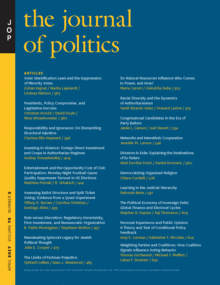 Weighting parties and coalitions: how coalition signals influence voting behaviorThomas Gschwend, Michael F Meffert, and Lukas F StoetzerThe Journal of Politics 2017
Weighting parties and coalitions: how coalition signals influence voting behaviorThomas Gschwend, Michael F Meffert, and Lukas F StoetzerThe Journal of Politics 2017Democratic accountability is characterized as weak in parliamentary systems where voters cannot choose their government directly. We argue that coalition signals about desirable and undesirable coalitions that might be formed after the election help to provide this essential aspect of democratic government. We propose a simple model that identifies the effect of coalition signals on individual vote decisions. Based on survey experiments in two different countries we show how coalition signals change the relative weight of voters’ party and coalition considerations. Coalition signals increase the importance of coalition considerations and, at the same time, decrease the importance of party considerations in voters’ decision calculus, leading some voters to change their vote intention.
@article{gschwend2017weighting, bibtex_show = {true}, title = {Weighting parties and coalitions: how coalition signals influence voting behavior}, status = {published}, impact = {1}, project = {pec}, author = {Gschwend, Thomas and Meffert, Michael F and Stoetzer, Lukas F}, journal = {The Journal of Politics}, volume = {79}, number = {2}, preview = {jop1.gif}, website = {https://www.journals.uchicago.edu/doi/abs/10.1086/688678}, pages = {642--655}, pdf = {Gschwend_et_al_2017_Weighting_Parties_and_Coalitions.pdf}, year = {2017}, publisher = {University of Chicago Press Chicago, IL} } -
 Zweitstimme. org. Ein strukturell-dynamisches Vorhersagemodell für BundestagswahlenPolitische Vierteljahresschrift 2017
Zweitstimme. org. Ein strukturell-dynamisches Vorhersagemodell für BundestagswahlenPolitische Vierteljahresschrift 2017Wir berichten die Ergebnisse einer ex-ante-Vorhersage der Zweitstimmenergebnisse für die Bundestagswahl 2017. Dazu kombinieren wir Daten veröffentlichter Umfragen mit strukturellen Informationen. Das Modell trägt den Eigenheiten von Vielparteiensystemen Rechnung und erlaubt es, Aussagen über die Wahrscheinlichkeit bestimmter Wahlergebnisse zu treffen, z. B. der Mehrheit der Sitzanteile für eine Partei oder der rechnerischen Mehrheit für verschiedene Koalitionsoptionen. Die Vorhersagen des Modells werden auf der Plattform zweitstimme.org veröffentlicht und aktualisiert. Unser Ansatz hat dabei nicht nur akademischen Wert: Wir geben Journalisten, Experten und Bürgern Informationen an die Hand, die helfen können, tatsächliche Parteiunterst/utzung einzuschätzen und letztlich besser informierte Wahlentscheidungen zu treffen.
@article{munzert2017zweitstimme, bibtex_show = {true}, status = {published}, impact = {3}, title = {Zweitstimme. org. Ein strukturell-dynamisches Vorhersagemodell f{\"u}r Bundestagswahlen}, preview = {pvs1.gif}, website = {https://www.jstor.org/stable/26427772}, author = {Munzert, Simon and Stötzer, Lukas and Gschwend, Thomas and Neunhoeffer, Marcel and Sternberg, Sebastian}, journal = {Politische Vierteljahresschrift}, pages = {418--441}, year = {2017}, publisher = {NOMOS Verlagsgesellschaft mbH \& Co. KG} }
2016
-
 What drives rental votes? How coalitions signals facilitate strategic coalition votingThomas Gschwend, Lukas Stoetzer, and Steffen ZittlauElectoral Studies 2016
What drives rental votes? How coalitions signals facilitate strategic coalition votingThomas Gschwend, Lukas Stoetzer, and Steffen ZittlauElectoral Studies 2016Rental voting is a coalition voting strategy, by which supporters of a senior coalition partner cast their vote for the prospective junior coalition partner to secure its representation in parliament and, hence, the formation of this coalition. We make transparent that previous research has only studied rental-voting in contexts, in which coalition signals were consistent with the rental-vote logic. Employing a qualitative identification strategy, we find evidence for rental voting only in the context with consistent coalition signals. Moreover, respondents exposed to consistent coalition signals behave similarly to voters who most likely did not receive the inconsistent coalition signals they had been exposed to.
@article{gschwend2016drives, bibtex_show = {true}, status = {published}, title = {What drives rental votes? How coalitions signals facilitate strategic coalition voting}, impact = {2}, author = {Gschwend, Thomas and Stoetzer, Lukas and Zittlau, Steffen}, journal = {Electoral Studies}, volume = {44}, website = {https://www.sciencedirect.com/science/article/abs/pii/S0261379416303031}, pages = {293--306}, preview = {es.gif}, pdf = {https://www.sowi.uni-mannheim.de/media/Lehrstuehle/sowi/Gschwend/Articel/Gschwend_et_al._2016_-_What_drives_rental_votes.pdf}, year = {2016}, publisher = {Pergamon} }
2015
-
 Multidimensional spatial voting with non-separable preferencesLukas F. Stoetzer, and Steffen ZittlauPolitical Analysis 2015
Multidimensional spatial voting with non-separable preferencesLukas F. Stoetzer, and Steffen ZittlauPolitical Analysis 2015In most multidimensional spatial models, the systematic component of agent utility functions is specified as additive separable. We argue that this assumption is too restrictive, at least in the context of spatial voting in mass elections. Here, assuming separability would stipulate that voters do not care about how policy platforms combine positions on multiple policy dimensions. We present a statistical implementation of Davis, Hinich, and Ordeshook’s (1970) Weighted Euclidean Distance model that allows for the estimation of the direction and magnitude of non-separability from vote choice data. We demonstrate in a Monte-Carlo experiment that conventional separable model specifications yield biased and/or unreliable estimates of the effect of policy distances on vote choice probabilities in the presence of non-separable preferences. In three empirical applications, we find voter preferences on economic and socio-cultural issues to be non-separable. If non-separability is unaccounted for, researchers run the risk of missing crucial parts of the story. The implications of our findings carry over to other fields of research: checking for non-separability is an essential part of robustness testing in empirical applications of multidimensional spatial models.
@article{stoetzer2015multidimensional, bibtex_show = {true}, status = {published}, title = {Multidimensional spatial voting with non-separable preferences}, author = {Stoetzer, Lukas F. and Zittlau, Steffen}, impact = {1}, journal = {Political Analysis}, volume = {23}, url = {https://doi.org/10.1093/pan/mpv013}, website = {https://doi.org/10.1093/pan/mpv013}, pdf = {Multidimensional_spatial_voting_with_non-separable_preferences_PA.pdf}, number = {3}, pages = {415--428}, altmetric = {4186035}, year = {2015}, preview = {pa.jpg}, publisher = {Cambridge University Press} } -
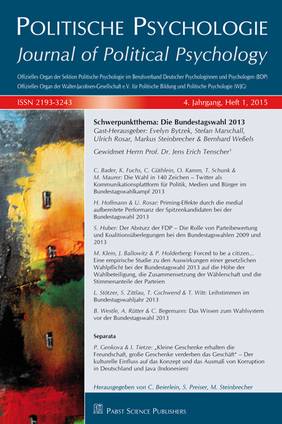 Leihstimmen im Bundestagswahljahr 2013Lukas Stoetzer, Steffen Zittlau, Thomas Gschwend, and Tobias WittPolitische Psychologie 2015
Leihstimmen im Bundestagswahljahr 2013Lukas Stoetzer, Steffen Zittlau, Thomas Gschwend, and Tobias WittPolitische Psychologie 2015Das Thema Leihstimmen erhielt im Wahljahr 2013 besondere Aufmerksamkeit. Während Leihstimmen der FDP einen unerwartet hohen Stimmanteil bei der Landtagswahl in Niedersachsen bescherten, verfehlte die FDP bei der Landtagswahl in Bayern und auch bei der Bundestagswahl den Einzug ins Parlament. In der politischen Berichterstattung wurde das Ausscheiden der FDP zumeist auch darauf zurückgeführt, dass in diesen Wahlen keine Leihstimmen vergeben wurden. Diese Interpretation stellt individuenbasierte Theorien strategischen Wählens in Frage. Diesen zufolge sollten Unionsanhänger mit starken Präferenzen für eine schwarz-gelbe Koalition in allen drei Wahlen Anreize gehabt haben, die FDP mit ihrer Zweitstimme zu unterstützen, wenn sie deren Einzugschancen als unsicher bewerteten. In diesem Licht ist es auch keine ausgemachte Sache, dass es kein Leihstimmverhalten in Bayern und im Bund gab - lediglich dass es zu wenige gab, um den Einzug der FDP zu sichern. Dieser Beitrag überprüft anhand einer statistischen Auswertung von Wählerbefragungsdaten die Erklärungskraft des individuenbasierten Erklärungsansatzes. Lässt sich Leihstimmverhalten in allen drei Wahlen identifizieren? Wir finden empirische Evidenz für strategisches Leihstimmverhalten bei der Landtagswahl in Niedersachsen, aber nicht bei der Bayern- und undestagswahl. Unsere Ergebnisse deuten darauf hin, dass die Erklärungskraft des individuenbasierten Ansatzes kontextabhängig ist. Dies unterstreicht die Bedeutung von Faktoren auf der Parteien- und Wahlebene für die Erklärung strategischen Wahlhandelns.
@article{stotzer2015leihstimmen, bibtex_show = {true}, status = {published}, project = {pec}, title = {Leihstimmen im Bundestagswahljahr 2013}, author = {Stoetzer, Lukas and Zittlau, Steffen and Gschwend, Thomas and Witt, Tobias}, impact = {3}, journal = {Politische Psychologie}, volume = {4}, number = {1}, pdf = {Stoetzer_etal_Leihstimmen.pdf}, pages = {88--107}, year = {2015}, preview = {polpsc.jpg}, publisher = {Pabst Science Publ.} }